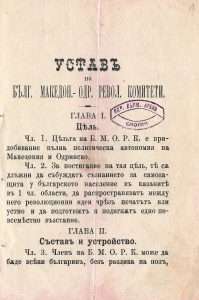Historiography in North Macedonia
Historiography in North Macedonia is the methodology of historical studies used by the historians of that country. It has been developed since 1945 when SR Macedonia became part of Yugoslavia. According to Stefan Troebst it has preserved nearly the same agenda as the marxist historiography from the times of the Socialist Federal Republic of Yugoslavia.[2] The generation of Macedonian historians closely associated with the Yugoslav period who worked on the actual national myths of that time are still in charge of the institutions. In fact, in the field of historiography, Yugoslav communism and Macedonian nationalism are closely related.[3] According to Ulf Brunnbauer, modern Macedonian historiography is highly politicized, because the Macedonian nation-building process is still in development. Diverging approaches are discouraged and people who express alternative views risk economic limitations, failure of academic career and stigmatization as "national traitors".[4] Troebst wrote already in 1983 that historical research in the SR Macedonia was not a humanist, civilizing end in itself, but was about direct political action.[5] No such case of reciprocal dependence of historiography and politics has been observed in modern Europe.[6] Despite ethnic Macedonians very seldom appear in pre-20th century primary sources, recently a nation-building project was promoted to impose the deceptive idea that the Macedonian nation is the oldest on the Balkans, with an unbroken continuity from Antiquity to Modern times.[7] Some domestic and foreign scholars have criticized this agenda of a denialist historiography, whose goal is to affirm the continuous existence of a separate Macedonian nation throughout history.[8] This controversial worldview is ahistorical, as it projects modern ethnic distinctions into the past.[9] Such an enhanced, ethnocentric reading of history contributes to the distortion of the Macedonian national identity and degrades history as an academic discipline.[10] Under such historiographies generations of students were educated in pseudo-history.[11]
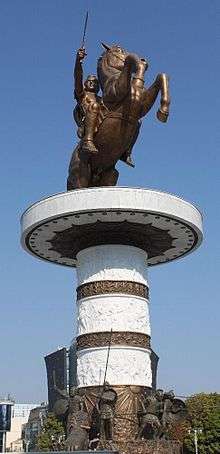

History
The contemporary Macedonian historical narrative is rooted in communist groups active during the interwar period, especially in the 1930s, when the Comintern issued a special resolution in their support. According to them, the Macedonian nation was forged through a differentiation from the earlier Bulgarian nation. The Macedonian awakening in the 19th century took place as part of the Bulgarian National Revival, but managed to evolve separately in the early 20th century.[12] Those circles were, however, not the first ones to develop separate Macedonian historical interpretations. In 1892 Georgi Pulevski, the first Macedonian national activist, completed a "General History of the Macedonian Slavs." It was only after the Second World War, however, that those writings were widely appreciated, as prior to the establishment of Communist Yugoslavia, the existence of a separate Macedonian nation was still not recognized.
The glorification of the Yugoslav partisan movement became one of the main components of the post-war Yugoslav political propaganda. As a result, the leader of the new Socialist Republic of Macedonia – Lazar Koliševski, initially proclaimed that its history has begun with the start of the communist struggle during the Second World War, while early 20th century events and organizations as the Ilinden Uprising and the IMRO were mere Bulgarian conspiracies.[13][14] Following direct political instructions from Belgrade, those historical studies were expanded.[15] New Macedonian historiography held, as a central principle, that Macedonian history was distinctively different from that of Bulgaria. Its primary goal was to create a separate Macedonian national consciousness, with an "anti-Bulgarian" or "de-Bulgarizing" trend, and to sever any ties with Bulgaria.[16] This distinct Slavic consciousness would inspire identification with Yugoslavia.
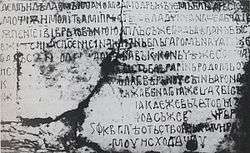
The first national scientific institution in this field – the Institute for National History of the federate republic was established in 1948. The historiographic narrative in the first two decades afterwards was expanded to the early 19th century, during which, as it was believed then, was the beginning of the history of the Macedonian people. However, the personalities from the area included into the new narrative also played a significant role in the Bulgarian National Revival. This problem was solved by the Communist system with censorship, control on historical information, and manipulations.[18] Numerous prominent activists with pro-Bulgarian sentiments from the 19th and the early 20th centuries were described as (ethnic) Macedonians. Due to the fact that in many documents of that period the local Slavic population is not referred to as "Macedonian" but as "Bulgarian", Macedonian historians argue that it was Macedonian, regardless of what is written in the records. They have also claimed that "Bulgarian" at that time was a term, not related to any ethnicity, but was used as a synonym for "Slavic", "Christian" or "peasant".[19]
Efforts were made since the late 1960s to expand the narrative into the Middle Ages. As a result, in 1969 the first academic "History of the Macedonian nation" was published, where many historical figures from the area who had lived in the last millennium as Samuel of Bulgaria, were described as people with a "Macedonian (Slavic) identity". When the historians from the Skopje University published in 1985 their collection of documents on the struggle of the Macedonian people, they included into the excerpts of the medieval chronicles a footnote for every use of the term Bulgarian.[20] Almost all of the new historical agenda was traditionally claimed by the Bulgarian national historiography and till today it disputes the Macedonian historical readings.[21]
Post-independence
After the Republic of Macedonia gained independence in the late 20th century, the situation did not change significantly. Macedonian historiography did not revise much of the Yugoslav past, because almost all of its historical myths were constructed during the communist era. The reluctance for a thorough reevaluation of Yugoslav communist historiography was mainly caused by the fact that the very Macedonian nation, state and language were a result of Yugoslav communist policies, where this historiography had played a crucial role. For the mainstream local establishment, an attitude against Communist Yugoslavia is seen as anti-Macedonism.[24]
Macedonian historiography became important in the early 21st century in the face of an unsure reevaluation of the Yugoslav past and of an uneasy articulation of a new anticommunist narrative. It has sought a new horizon behind the mythological symbolism of ancient Macedon. For that purpose the borders of the ancient state were extended towards the north, much further than its actual historical extent. According to this new narrative, most of the cultural achievements of the Ancient Macedonians were actually (ethnic) Macedonian and therefore, Hellenism's true name would be Macedonism. This new historical trend, called antiquization, made the Macedonian nationality a thousand years older. In this view Ancient Macedonians were not Ancient Greek people and a separate existence of Ancient Macedonians in the Early Middle Ages is maintained, 800 years after the fall of their kingdom, as well as their admixture in the Byzantine Empire with the arriving early Slavic settlers in the late 6th century.
In 2009 the first Macedonian Encyclopedia was issued by the Macedonian Academy of Sciences and Arts. The issuance of the encyclopedia caused international and internal protest because of its content and its authors have been subjected to severe criticism. Even some Macedonian academics criticised the book as hastily prepared and politically motivated. Soon the scandalous encyclopedia was withdrawn from the bookstores. Macedonian Canadian historian Andrew Rossos has published in 2008 the first professional English language overview of the history of Macedonia, however Stefan Troebst suggests that his narrative is enough affected by the views in the R. Macedonia and thus is representing the latest developments in the Macedonian historiography as viewed in Skopje.
Alternative views

After the fall of Communism, historical revisionists in the Republic of Macedonia questioned the narrative established in Communist Yugoslavia. People such as Ivan Mikulčić, Zoran Todorovski and Slavko Milosavlevski tried to openly oppose the popular historical myths in the Republic of Macedonia. Mikulčić, for example, proved through archaeological evidence that there weren't any ancient Macedonians when the Early Slavs arrived in Macedonia. He also found several Bulgar settlements on the territory of the modern republic and argued the Slavs in Macedonia adopted the ethnonym Bulgarians in the 9th century. Todorovski has argued that all Macedonian revolutionaries from the early 20th century and beyond identified themselves as Bulgarians. Milosavlevski challenged the myth of the significance of the communist partisan resistance movement against the Bulgarian "fascistic occupiers" during the Second World War. Today are also some revisionist opinions in North Macedonia, the conflict during WWII there, was merely a civil war.[28] Such studies became the only exception to the new Macedonian historiography, with most historians staying loyal to the political elite, writing publications appropriating the Hellenistic part of the Macedonian past, the medieval Bulgarian Empire and the Bulgarian national revival from the Ottoman period.[29]
This policy of claiming ethnic Macedonian past during Ancient, Medieval and Ottoman times is facing criticism by other academics and politicians in the country itself, such as Denko Maleski, Miroslav Grčev, Ljubcho Georgievski and others. It demonstrates feebleness of archaeology and historiography, as well as some kind of ethnic marginalization.[30] These intellectuals from the Macedonian elite admit that the distinct Macedonian nation is a recent phenomenon that developed in the years around the Second World War. Such views are spread among well educated citizens that search for the scientific resolution of the nation-building process. Despite significant parts of the leading establishment strongly opposing the articulation of such views, some prominent members of the elite disclose their rational views.[31]
Foreign historiographic studies
The mainstream European historiography maintains that the idea of separate Macedonian nation was developed mainly during the Second World War and was adopted en masse immediately after it.[32] Per Carsten Wieland, Stefan Troebst sees the Macedonian nation building as an ideal example of Gellner's theory of nationalism. Since the creation of the Yugoslav Macedonia it was realized immediately.[33] Whether in Antiquity the Ancient Macedonians were originally a Greek tribe or not is ultimately a redundant question according to professor of anthropology Loring Danforth.[34] John Van Antwerp Fine states that throughout the Middle Ages and Ottoman era modern Bulgarians and Macedonians comprised a single people.[35] Per Bernard Lory the ethnic divergence between them occurred mainly in the first half of the 20th century.[36] Alexander Maxwell maintains that scarcely by the middle of that century, Macedonians began to see Macedonian and Bulgarian loyalties as mutually exclusive.[37] According to historian Eugene N. Borza, the Macedonians, who are a recently emergent people and have had no history, are in search of their past. This search is an attempt to help legitimize their unsure present, surviving in the disorder of Balkan politics.[38] Anthropologist Ivaylo Dichev claims that the Macedonian historiography has the impossible task of filling in the huge gaps between the ancient kingdom of Macedon that collapsed in the 2nd century BC, the 10th-11th century state of the Cometopuli, and Yugoslav Macedonia, established in the middle of the 20th century.[39] Despite the myths of national purity and continuity that came to dominate the official Macedonian historiography, something not unusual for the Balkan region, Ipek Yosmaoglu affirms there is not much to be gained from a search for a Macedonian national lineage, because the Macedonian nationhood was shaped mainly in the decades following World War II.[40]
Recent developments
Surveys on the effects of the controversial nation-building project Skopje 2014 and on the perceptions of the population of Skopje revealed a high degree of uncertainty regarding the latter's national identity. A supplementary national poll showed that there was a great discrepancy between the population's sentiment and the narrative the state sought to promote.[41] According to F.A.K. Yasamee, the Macedonians are a striking instance of the mutability of national identity.[42]
Recently the Macedonian political elite seems interested in a debate about the national historical narrative with Bulgaria and Greece. With respect to the Macedonian narrative, both Greek and Bulgarian historiographies have questioned the Macedonian historiography's factual basis, because it was constructed to come into conflict with the former two. Per Michael R. Palairet in the three-way dispute about Macedonia, the Bulgarian view is closer to the objective reality of history than either the Greek or Macedonian, but the Macedonian historiographical version violates common sense and the historical record much more than either the Greek or Bulgarian ones.[43]
The governments of Bulgaria and Macedonia signed a friendship treaty to bolster the complicated relations between the two Balkan states in August 2017. On its ground a joint commission on historical and educational issues was formed in 2018. This intergovernmental commission is a forum where controversial historical issues will be raised and discussed, to resolve the problematic readings of history. In June 2018, Greece and Macedonia also signed an agreement to end their long disputes, which resulted in Macedonia being renamed the Republic of North Macedonia in February 2019. It also provides for the creation of a commission similar to that of the treaty signed with Bulgaria. In an interview given in 2019, the co-president of the joint historical commission with Bulgaria from the Macedonian side - prof. Dragi Karev, has appealed that it is necessary to acknowledge, there have been made a forgeries from the Macedonian side. Thus, instead of "Bulgarian" as in the original artifacts, in the Macedonian textbooks was written "Macedonian". According to him, for many years the historiography in North Macedonia has been a function of the process of nation-building.[44]
However, with nationalism in the three countries rising, there are still Greek and Bulgarian scholars who claim a Macedonian nation did not exist until the middle of the 20th century and therefore could not exist in the present. In Skopje, meanwhile, there are growing concerns that the negotiations with the country's neighbors over its history may jeopardize the Macedonian government or even lead to violence and internal clashes. In the early October 2019, Bulgaria has set a lot of tough terms for North Macedonia's EU progress. The Bulgarian government accepted an ultimate "Framework Position", where has warned that Bulgaria will not allow the EU integration of North Macedonia to be accompanied by European legitimization of an anti-Bulgarian ideology, sponsored by Skopje authorities. In the list are more than 20 demands and a timetable to fulfill them, during the process of North Macedonia's accession negotiations. It states that the rewriting of the history of part of the Bulgarian people after 1944 was one of the pillars of the bulgarophobic agenda of then Yugoslav communism. Bulgarian National Assembly voted on 10 October and approved this "Framework Position" put forward by the government on the EU accession of North Macedonia.[45]
Gallery
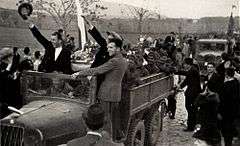 Bulgarian invasion in Vardar Banovina, April 1941. Bulgarians were greeted as liberators.[46] The local communists then joined the BCP and refused any military actions against the Bulgarians. After the war, the Yugoslav communist historiography did a lot to equate the term Bulgarian with "fascist occupier".[47]
Bulgarian invasion in Vardar Banovina, April 1941. Bulgarians were greeted as liberators.[46] The local communists then joined the BCP and refused any military actions against the Bulgarians. After the war, the Yugoslav communist historiography did a lot to equate the term Bulgarian with "fascist occupier".[47]- The former Bulgarian police station in Prilep was attacked by Partisan detachment on 11 October 1941. Today the object is memorial museum. In fact the only victim of the attack, celebrated as the day of the Macedonian Uprising against Bulgarian fascists, was a local man conscripted in the Bulgarian police.[48]
 Macedonian historians have accused the Bulgarian forces of several atrocities during WWII, most prominent among which is the massacre of 12 young civilians at the village of Vataša. However except part of the participating soldiers, the officer commanding the operation himself was also s local staff.[49][50]
Macedonian historians have accused the Bulgarian forces of several atrocities during WWII, most prominent among which is the massacre of 12 young civilians at the village of Vataša. However except part of the participating soldiers, the officer commanding the operation himself was also s local staff.[49][50]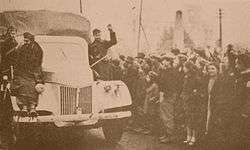
See also
- Macedonian Question
- Macedonian nationalism
- History of North Macedonia
- 2018 Macedonian referendum
References
- Elisabeth Kontogiorgi, Population Exchange in Greek Macedonia: The Rural Settlement of Refugees 1922-1930, Oxford Historical Monographs, Clarendon Press, 2006, ISBN 0191515558, p. 12.
- Stefan Troebst, Historical Politics and Historical 'Masterpieces' in Macedonia before and after 1991, New Balkan Politics, 2003.
- Roumen Daskalov, Diana Mishkova as ed., Entangled Histories of the Balkans - Volume Two: Transfers of Political Ideologies and Institutions, BRILL, 2013, ISBN 9004261915, p. 499.
- Ulf Brunnbauer, "Serving the Nation: Historiography in the Republic of Macedonia (FYROM) after Socialism", Historien, Vol. 4 (2003-4), pp. 174-175.
- Morten Dehli Andreassen, June 2011; "If you don’t vote VMRO you’re not Macedonian". A study of Macedonian identity and national discourse in Skopje. Thesis submitted in partial fulfillment of Master of Arts Degree. Department of Social Anthropology, University of Bergen, p. 81.
- "At any rate, the beginning of the active national-historical direction with the historical “masterpieces”, which was for the first time possible in 1944, developed in Macedonia much harder than was the case with the creation of the neighbouring nations of the Greeks, Serbs, Bulgarians and others in the 19th century. These neighbours almost completely "plundered" the historical events and characters from the land, and there was only debris left for the belated nation. A consequence of this was that first that parts of the “plundered history” were returned, and a second was that an attempt was made to make the debris become a fundamental part of an autochthonous history. This resulted in a long phase of experimenting and revising, during which the influence of non-scientific instances increased. This specific link of politics with historiography in the Socialist Republic of Macedonia... was that this was a case of mutual dependence, i.e. influence between politics and historical science, where historians do not simply have the role of registrars obedient to orders. For their significant political influence, they had to pay the price for the rigidity of the science... There is no similar case of mutual dependence of historiography and politics on such a level in Eastern or Southeast Europe." For more see: Stefan Trobest, "Historical Politics and Histrocial ‘Masterpieces’ in Macedonia before and after 1991", New Balkan Politics, 6 (2003).
- Klaus Roth, Asker Kartarı as authors and ed., Cultures of Crisis in Southeast Europe, Volume 2, LIT Verlag Münster, 2017, ISBN 3643907915, p. 169.
- Sinisa Jakov Marusic, New Statue Awakens Past Quarrels in Macedonia. BalkanInsight, 13 July 2012, cited in War in the Balkans: Conflict and Diplomacy before World War I by James Pettifer, I.B.Tauris, 2015, ISBN 0857739689.
- Kyril Drezov, Macedonian identity: an overview of the major claims in The New Macedonian Question with J. Pettifer as ed., Springer, 1999, ISBN 0230535798, p. 55.
- Irena Stefoska, Nation, Education and Historiographic Narratives: the Case of the Socialist Republic of Macedonia (1944-1990); Introduction In discussions of identities (ethnic, national, religious, gender, etc.), Fragments of the History of Macedonian Nationalism: An Introduction to the Research Problem, pp. 34-35.
- The past was systematically falsified to conceal the fact that many prominent 'Macedonians' had supposed themselves to be Bulgarian, and generations of students were taught the "pseudo-history" of the 'Macedonian nation." For more see: Michael L. Benson, Yugoslavia: A Concise History, Edition 2, Springer, 2003, ISBN 1403997209, p. 89.
- Spyridon Sfetas, The Configuration of Slavomacedonian Identity. A Painful Evolution. Thessaloniki: Vanias, 2003. Balcanica XLVI, pp. 426-429. Reviewed by Athanasios Loupas.
- Мичев. Д. Македонският въпрос и българо-югославските отношения – 9 септември 1944–1949, Издателство: СУ Св. Кл. Охридски, 1992, стр. 91.
- Initially the membership in the IMRO was restricted only for Bulgarians. Its first name was "Bulgarian Macedonian-Adrianople Revolutionary Committees", which was later changed several times. IMRO was active not only in Macedonia but also in Thrace (the Vilayet of Adrianople). Since its early name emphasized the Bulgarian nature of the organization by linking the inhabitants of Thrace and Macedonia to Bulgaria, these facts are still difficult to be explained from the Macedonian historiography. They suggest that IMRO revolutionaries in the Ottoman period did not differentiate between 'Macedonians' and 'Bulgarians'. Moreover, as their own writings attest, they often saw themselves and their compatriots as 'Bulgarians'. All of them wrote in standard Bulgarian language. For more see: Brunnbauer, Ulf (2004) Historiography, Myths and the Nation in the Republic of Macedonia. In: Brunnbauer, Ulf, (ed.) (Re)Writing History. Historiography in Southeast Europe after Socialism. Studies on South East Europe, vol. 4. LIT, Münster, pp. 165-200 ISBN 382587365X.
- Stefan Troebst, "Die bulgarisch-jugoslawische Kontroverse um Makedonien 1967-1982". R. Oldenbourg, 1983, ISBN 3486515217, p. 15.
- Stephen E. Palmer, Robert R. King, Yugoslav communism and the Macedonian question, Archon Books, 1971, ISBN 0208008217, pp. 6-7.
- J. Pettifer ed., The New Macedonian Question, St Antony's Series, Springer, 1999, ISBN 0230535798, p. 75.
- Dejan Djokićas ed., Yugoslavism: Histories of a Failed Idea, 1918-1992; Hurst & Co. Publishers, 2003, ISBN 1850656630, pp. 121-122.
- Blaze Ristovski, Istorija na makedonskata nacija [History of the Macedonian Nation], Skopje, 1969, pp. 13-14.
- Chris Kostov, Contested Ethnic Identity: The Case of Macedonian Immigrants in Toronto, 1900-1996, Peter Lang, 2010, ISBN 3034301960, p. 109.
- Tchavdar Marinov, Historiographical Revisionism and Re-Articulation of Memory in the Former Yugoslav Republic of Macedonia, Sociétés politiques comparées, issue 25, May 2010, p. 3.
- The dogma of Macedonian historiography is that it was an ‘ethnic Macedonian’ organisation and the acronym IMARO has been routinely abbreviated in Macedonian historiography to IMRO to avoid difficult questions about the presence in the same organisations of people nowadays described as ‘ethnic Macedonians’ from geographic Macedonia – together with ‘ethnic Bulgarians’ from the Vilajet of Adrianople. In this cases a present-day reality is projected wholesale into the past. For more see: Kyril Drezov, Macedonian identity: an overview of the major claims in The New Macedonian Question with J. Pettifer as ed., Springer, 1999, ISBN 0230535798, p. 55.
- Mishkova Diana as ed., We, the People: Politics of National Peculiarity in Southeastern Europe, Central European University Press, 2009, ISBN 9639776289, pp. 113-114.
- Ulf Brunnbauer, "Pro‐Serbians" vs. "Pro‐Bulgarians": Revisionism in Post‐Socialist Macedonian Historiography, first published on 21 December 2005 https://doi.org/10.1111/j.1478-0542.2005.00130.x
- Tome Boshevski, Aristotel Tentov, Tracing the script of the Ancient Macedonians. This paper presents the results of research realized within the project "Deciphering the Middle Text of the Rosetta Stone", supported by Macedonian Academy of Sciences and Arts, 2003 – 2005.
- Comparative analysis of the results of deciphering the middle text on the Rosetta stone, Tome Boševski, Aristotel Tentov, MANU, Vol 31, No 1-2 (2010) DOI: https://dx.doi.org/10.20903/csnmbs.masa.2010.31.1-2.23
- Џабир Дерала и Кирстен Шонефелд, Соочување со реалноста, ЦИВИЛ-Центар за слобода, Скопје, 2014, ISBN 6086562954, p. 88.
- Стенографски белешки от Тринаесеттото продолжение на Четиринаесеттата седница на Собранието на Република Македонија, одржана на 17 јануари 2007 година.
- Chris Kostov, Contested Ethnic Identity: The Case of Macedonian Immigrants in Toronto, 1900-1996; Vol. 7 от Nationalisms across the globe; Peter Lang, 2010 ISBN 3034301960, p. 107-108.
- Ludomir R. Lozny (2011). Comparative Archaeologies: A Sociological View of the Science of the Past. Springer, ISBN 1441982248, p. 427.
- Naoum Kaytchev, Being Macedonian: Different Types of Ethnic Identifications in the Contemporary Republic of Macedonia. – Politeja (Krakow, Poland), № 30 (2014), 122–131.
- Naoum Kaytschev, Being Macedonian: different types of ethnic identifications in the contemporary Republic of Macedonia. No. 30, Macedonia in 20th and 21st century (2014), pp. 123-132, Księgarnia Akademicka, URL: https://www.jstor.org/stable/24919720 .
- "National language, national literature, national history and national church were not available in 1944, but they were accomplished in a short time. The south-east-Slavic regional idiom of the area of Prilep-Veles was codified as the script, normed orthographically by means of the Cyrillic Alphabet, and taken over immediately by the newly created media. And the people have been patching up the national history ever since. Thus, they are forming more of an "ethnic" than a political concept of nation. For more, see: One Macedonia With Three Faces: Domestic Debates and Nation Concepts, in Intermarium; Columbia University; Volume 4, No. 3 (2000–2001).
- Danforth, Loring M. (1997). The Macedonian Conflict: Ethnic Nationalism in a Transnational World. Princeton, Princeton University Press. ISBN 0-691-04356-6, p. 169.
- John Van Antwerp Fine, "The Early Medieval Balkans: A Critical Survey from the Sixth to the Late Twelfth Century"; University of Michigan Press, 1991, ISBN 0472081497, pp. 36–37.
- Bernard Lory, The Bulgarian-Macedonian Divergence, An Attempted Elucidation, INALCO, Paris in Developing Cultural Identity in the Balkans: Convergence Vs. Divergence with Raymond Detrez and Pieter Plas as ed., Peter Lang, 2005, ISBN 9052012970, pp. 165-193.
- Alexander Maxwell, Slavic Macedonian Nationalism: From "Regional" to "Ethnic"' in Region, Regional Identity and Regionalism in Southeastern Europe, Part 1. with Klaus Roth and Ulf Brunnbauer as ed., LIT, Münster, 2008. ISBN 3825813878, pp. 127-154.
- Eugene N. Borza, Macedonia Redux in The Eye Expanded: Life and the Arts in Greco-Roman Antiquity with Frances B. Titchener, and Richard F. Moorton as ed. University of California Press, 1999, ISBN 0520210298, p. 259.
- Dichev, Ivaylo, Eros Identiteta, In: Dušan Bjelić, Obrad Savić (eds.), Balkan kao metafora: između globalizacije i fragmentacije. Beograd: Beogradski krug, 2003, pp. 269-284.
- İpek Yosmaoğlu, Blood Ties: Religion, Violence and the Politics of Nationhood in Ottoman Macedonia, 1878–1908, Cornell University Press, 2013, ISBN 0801469791, p. 16.
- Muhić, Maja; Takovski, Aleksandar (2014): Redefining National Identity in Macedonia. Analyzing Competing Origins Myths and Interpretations through Hegemonic Representations. In Etnološka tribina 44 (37), p. 144.
- F.A.K. Yasamee, Nationality in the Balkans: The case of the Macedonians in Balkans: A Mirror of the New World Order, Istanbul: EREN, 1995; pp. 121-132.
- Michael Palairet, Macedonia: A Voyage through History (Vol. 1, From Ancient Times to the Ottoman Invasions), Cambridge Scholars Publishing, 2016, ISBN 1443888435, p. 16.
- Проф. Драги Георгиев: Да признаем, че е имало и фалшифициране - вместо "българин" са писали "македонец"- това е истината. Factor.bg, 21 March 2020.
- Sinisa Jakov Marusic, Bulgaria Sets Tough Terms for North Macedonia’s EU Progress Skopje. BIRN; 10 October 2019.
- Raymond Detrez, The A to Z of Bulgaria, G - Reference, SCARECROW PRESS INC, 2010, ISBN 0810872021, p. 485.
- Carl Skutsch as ed., Encyclopedia of the World's Minorities, Routledge, 2013, ISBN 1135193886, p. 766.
- Македонизмът и съпротивата на Македония срещу него, Коста Църнушанов, Унив. изд. "Св. Климент Охридски", София, 1992 г. стр. 206.
- Македонска Енциклопедија, МАНУ, Скопjе, 2009, Том I (А - Л), стр. 76.
- Ташев, Т., „Българската войска 1941 – 1945 – енциклопедичен справочник“, София, 2008, „Военно издателство“, ISBN 978-954-509-407-1, стр. 9.
- Crawford, Steve. The Eastern Front Day by Day, 1941-45: A Photographic Chronology, Potomac Books, 2006, ISBN 1597970107, p. 170: "November 13, 1944, ...The Bulgarian First Army ejects Army Group E from Skopje..."
- Livanios, Dimitris, The Macedonian Question: Britain and the Southern Balkans 1939-1949, Oxford University Publishing, 2008, ISBN 0191528722, pp. 134-135.
- Michael Palairet, Macedonia: A Voyage through History (Vol. 2), Cambridge Scholars Publishing, 2016, ISBN 1443888494, p. 212.
- The first unit, which entered at 6.30pm Skopje, already left from the Germans under the pressure of the Bulgarian army, was the reconnaissance platoon of the Second infantry division of the 4th Bulgarian army. For the liberation of Skopje contributed also detachments of the Second infantry division of the First Bulgarian Army. They forced the withdrawing Nazi detachments to retreat the city and on November 13th at 11pm took under their control the southern and the southeastern areas of the city. At the midnight they seized also its center. Georgi Daskalov, Bulgarian-Yugoslav political relations, 1944-1945, Kliment Ohridski University Press, 1989, p. 113; (in Bulgarian).
